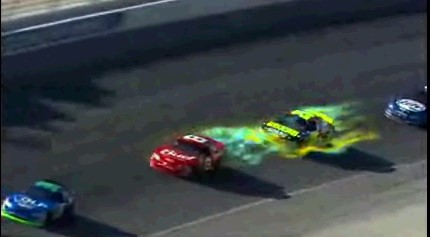ESPN to introduce draft-track technology
Now, as NASCAR NEXTEL Cup racing returns to ESPN with Sunday’s Allstate 400 at the Brickyard, a technical innovation developed by ESPN and SportVision will allow NASCAR fans to see the air when they watch ESPN’s coverage of the NASCAR NEXTEL Cup and NASCAR Busch Series.
 Beginning with Sunday’s telecast of the Allstate 400 at the Brickyard from Indianapolis Motor Speedway, ESPN, which has televised more NASCAR Cup Series races than any other network, will enhance its NASCAR coverage with Draft Track, a special effects package that will provide to viewers a never-before-seen effect that shows airflow created by NASCAR race cars.
Beginning with Sunday’s telecast of the Allstate 400 at the Brickyard from Indianapolis Motor Speedway, ESPN, which has televised more NASCAR Cup Series races than any other network, will enhance its NASCAR coverage with Draft Track, a special effects package that will provide to viewers a never-before-seen effect that shows airflow created by NASCAR race cars.
When ESPN’s producers activate Draft Track, viewers will see air flowing over and behind race cars as they speed around the track, whether there is one car or a multi-car pack on the television screen. The Draft Track airflow visualization will change as the cars, in relation each other, change position in real time on the racetrack, including passing, racing side by side or when cars are lined up nose to tail. The new effect will initially be used on replays.
“We continue to be fascinated with showing viewers things that you cannot see – the line of scrimmage in football, the strike zone in baseball, and the airflow in motorsports, especially relevant to NASCAR, known as drafting," said Jed Drake, ESPN senior vice president and executive producer. “Draft Track brings to life for the viewer an element of NASCAR racing that has been a much-discussed but unseen part of the sport for decades."
Draft Track was created by ESPN in collaboration with SportVision, the nation’s premier innovator of sports and entertainment products for fans, media companies and marketers and the creator of the pointers and telemetry used in ESPN’s NASCAR coverage this season. Using computational fluid dynamics information and wind tunnel data, SportVision developed a comprehensive model of the airflow as it affects cars in relation to each other. The system uses positioning data derived from SportVision’s patented RACEf/x system and the Draft Track computers calculate and determine the profile of the airflow many times per second on cars traveling at more than 200 mph.
Once the calculations are done, the airflow effect is then locked to the highlighted cars using SportVision optical tracking technology, and a visual representation of the airflow is inserted into the video that ESPN viewers see. The density, color and velocity of the airflow help illustrate the effects of drafting on car performance, and the effects vary with the behavior of the airflow.
“When we can show things that can't otherwise be seen, then we have really accomplished something very special for our viewers, and for our company," Drake said. “We're incredibly pleased that SportVision is willing to walk in lockstep with us to make these projects reality."
ESPN and SportVision worked together to create the “First and Ten Line" in football coverage, now used by nearly all networks, as well as the “K Zone" in baseball coverage. ESPN worked with another company to create the “Shot Spot" that is used in tennis coverage to track the path of the ball and where it hits the ground. All three of these have earned Sports Emmy Awards for ESPN for technical innovation.
The Indianapolis race is ESPN’s first NASCAR Cup race since 2000, but the network covered 262 Cup races during a 20-year period starting in 1981. ESPN and ABC will have live coverage of the final 17 races of the NASCAR NEXTEL Cup season, including all 10 races in the Chase for the NASCAR NEXTEL Cup on ABC. In addition, ESPN2 is the home of the NASCAR Busch Series all season, and its races are being televised with the same standards of production and effects that will be used in the Cup Series.
“We’re not finished experimenting and finding new technologies," Drake said. “It’s a hallmark of ESPN to constantly push the envelope and seek new ways to satisfy our curiosity and that of our viewers. NASCAR is one of the most exciting and dynamic sports on television and we will continue to seek out ways to make it even more appealing."
